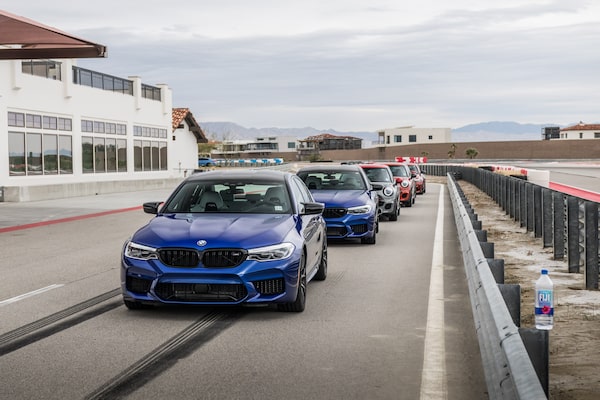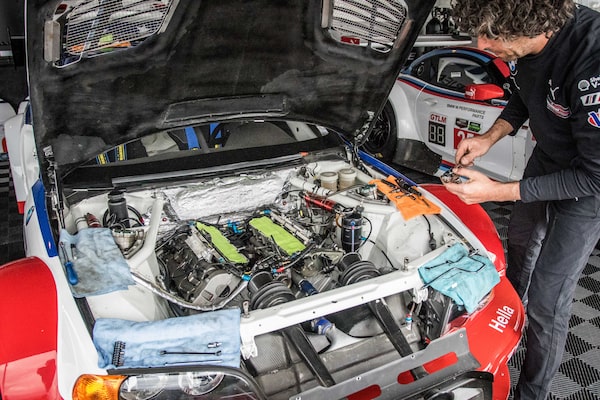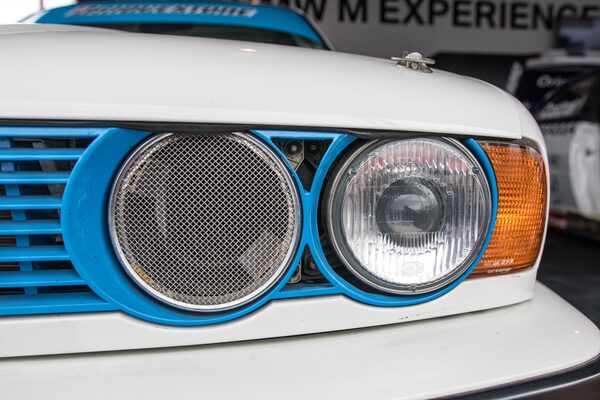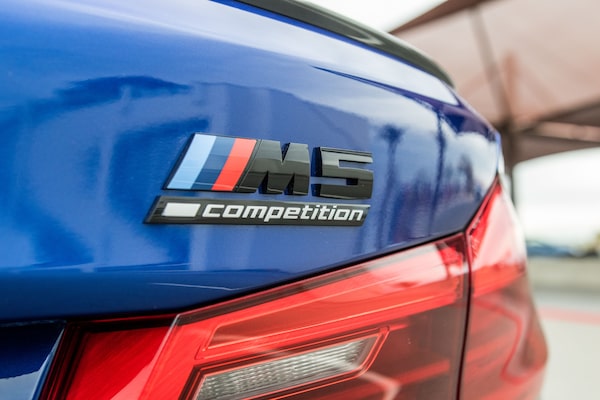
BMW M5s and Mini vehicles line up on a racetrack.Brendan McAleer
This windowless room, where cameras are forbidden, holds both a future that might have been and the present that is. Representing the former is the single prototype M8 of the 1990s, powered by a 549 hp V12 made by a company whose middle name is literally “Motor.” The latter hulks as a row of superpowered SUVs, each one a slap in the face to the laws of physics.
BMW’s M division was born in the crucible of motorsport, but now it’s become something else entirely. If the proto-M8 is the apogee of M’s audacity, a machine built to shame the Ferraris and Aston-Martins of its day, then the M-badged X3, X4 and X5 that sit across from it are the current height of pragmatism. Consumers want crossovers, so why wouldn’t BMW build some of the fastest ones on the planet?
M was founded 47 years ago, and you have to wonder whether all this middle-aged spread has diluted the brand a little. Once, you could only find an M badge on a handful of super sedans and homologation specials; these days, appearance packages cram multiple M-badges onto every possible surface. Does M still stand for something unique?

Checking under the hood of a 2001 M3 GTR.Brendan McAleer
We can trace the origin of the breed back to May of 1972, and the flared-and-bewinged insanity of the 3.0CSL. After a brief hiatus from racing, BMW returned with a vengeance, bearing their now-iconic three-colour livery: light blue for Bavaria, red for a Texaco partnership and a purplish line between them to show the overlap.
In racing trim, the CSL touring car special bulged like Arnold Schwarzenegger in his prime, all swaggering muscularity. The twin-winged aerodynamics package earned the CSL the nickname “the Batmobile,” but while it was developed by BMW’s newly formed motorsports division, it didn’t yet wear the badge.
Instead, the first M car was a sort of phoenix rising from the ashes of failure. Co-developed with Lamborghini, the M1 took its design cues from a 1972 turbocharged concept, and was intended to fulfill homologation requirements so BMW could go racing. When Lamborghini's financial troubles got in the way, BMW had to take over.
An inline-six was designed by Paul Rosche, a mechanical genius who would leave his fingerprints all over the best engines from M division. By today’s standards, the road-going M1′s 273 hp output sounds fairly tame, but in 1978, that was more power than a 911 Turbo could muster.

The M3 line started with racing vehicles in the mid-80s before becoming legendary road cars.Brendan McAleer
More importantly, the M1′s development led directly to the M-badged road cars we all know and love. The path had already been set out by the M535i, which featured upgraded brakes, suspension and steering. Now, Rosche’s motorsport-influenced straight six was going to turn the 5-series into a weapon.
The first M5 was more engine than the car’s chassis could really handle, and what better recipe than that? In the North American market, the M5 was saddled with fairly ungainly-looking bumpers compared to the prettier Euro-spec versions, but the car was a success despite the lack of choice. All M5s exported across the Atlantic were black in colour, although Canadians at least had their choice of a black or tan interior (the United States initially only got beige leather).
On the track at Thermal, behind the wheel of a current M5 Competition Package, you can see just how far the M5's evolved. On the orientation lap, performed at a steady lope, this big sedan is comfortable and quiet. Light the afterburners on the 617hp twin-turbo V8, and the M5 chews up the straights, clawing out of hairpin turns with all-wheel-drive grip.
Endless arguments exist about which M5 is best (most people like the V8-powered E39; I’m partial to a 3.8L E34 Touring), but there’s no denying it’s a household name for speed and luxury. However, that’s not the only trick in the M-division book.

The M5 Competition is a big, comfortable sedan, but it's also capable of tearing up straights and ripping through hairpin turns.Brendan McAleer
In the mid-1980s, BMW built another homologation special, this time to compete in German touring-car racing (DTM). If you can believe it, the box-flared E30 M3 originally drew criticism for being powered by a four-cylinder engine, albeit one again designed by Rosche and capable of nearly 200hp.
As a racing machine, the original M3 was very successful. As a road car, it became a legend. If you were hoping to tuck one in your garage, the first thing on your list should be developing time travel, as they’ve shot up in value over the past few years.
Again, there's all kinds of hotly contested debate about which M3 is best, with most BMW fans agreeing that the 2000-2006 coupe is the tastiest. The modern M3/M4 is still eye-wideningly fast, but it's perhaps grown a little bulkier than its ancestors.
Which is not really a problem at all, thanks to the existence of the M2. On the same track as the M5, a Competition Package M2 felt agile and quick because of its compact dimensions, rather than electronic trickery. Get impatient with the throttle on corner exit and this scrappy little bulldog whips its tail out. It’s not the best way to produce quick lap times, but it is endless fun.
Which brings us to the elephants in the room: the M-badged crossovers. Common wisdom says that these are just BMW pandering to the masses, drifting away from their motorsport roots.
Except that, on track, the X3M and X4M aren’t quietly competent like the M5, but more like huge, tail-happy versions of the M2. At the wheel, one of the driving instructors onsite confessed that he preferred the X3M to the M5. They’re fun.

This 2016 M6 GTLM is part of a long line of BMW track stars.Brendan McAleer
As M approaches a half-century of history, fans can still hold on to the hope that there’s more than just badging going on here. And then there’s the last car in that windowless room, the new M8, a road-going version of the beast that the likes of racer Alex Zanardi campaigned at the 24 Hours of Daytona. You’ll see it soon, and don’t worry: M still stands for something special.
The writer was a guest of the automaker. Content was not subject to approval.
Shopping for a new car? Check out the new Globe Drive Build and Price Tool to see the latest discounts, rebates and rates on new cars, trucks and SUVs. Click here to get your price.
Stay on top of all our Drive stories. We have a Drive newsletter covering car reviews, innovative new cars and the ups and downs of everyday driving. Sign up for the weekly Drive newsletter, delivered to your inbox for free. Follow us on Instagram, @globedrive.